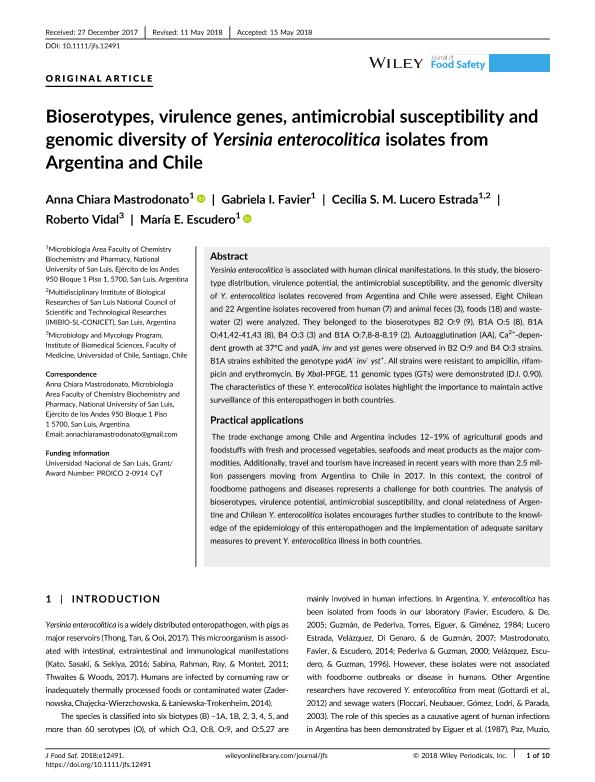Mostrar el registro sencillo del ítem
dc.contributor.author
Mastrodonato, Anna Chiara

dc.contributor.author
Favier, Gabriela Isabel

dc.contributor.author
Lucero Estrada, Cecilia Stella Marys

dc.contributor.author
Vidal, Roberto
dc.contributor.author
Escudero, María Esther

dc.date.available
2019-11-14T21:20:30Z
dc.date.issued
2018-10
dc.identifier.citation
Mastrodonato, Anna Chiara; Favier, Gabriela Isabel; Lucero Estrada, Cecilia Stella Marys; Vidal, Roberto; Escudero, María Esther; Bioserotypes, virulence genes, antimicrobial susceptibility and genomic diversity of Yersinia enterocolitica isolates from Argentina and Chile; Wiley Blackwell Publishing, Inc; Journal of Food Safety; 38; 5; 10-2018; 1-10
dc.identifier.issn
0149-6085
dc.identifier.uri
http://hdl.handle.net/11336/88993
dc.description.abstract
Yersinia enterocolitica is associated with human clinical manifestations. In this study, the bioserotype distribution, virulence potential, the antimicrobial susceptibility, and the genomic diversity of Y. enterocolitica isolates recovered from Argentina and Chile were assessed. Eight Chilean and 22 Argentine isolates recovered from human (7) and animal feces (3), foods (18) and wastewater (2) were analyzed. They belonged to the bioserotypes B2 O:9 (9), B1A O:5 (8), B1A O:41,42-41,43 (8), B4 O:3 (3) and B1A O:7,8-8-8,19 (2). Autoagglutination (AA), Ca2+-dependent growth at 37°C and yadA, inv and yst genes were observed in B2 O:9 and B4 O:3 strains. B1A strains exhibited the genotype yadA- inv- yst+. All strains were resistant to ampicillin, rifampicin and erythromycin. By XbaI-PFGE, 11 genomic types (GTs) were demonstrated (D.I. 0.90). The characteristics of these Y. enterocolitica isolates highlight the importance to maintain active surveillance of this enteropathogen in both countries. Practical applications: The trade exchange among Chile and Argentina includes 12–19% of agricultural goods and foodstuffs with fresh and processed vegetables, seafoods and meat products as the major commodities. Additionally, travel and tourism have increased in recent years with more than 2.5 million passengers moving from Argentina to Chile in 2017. In this context, the control of foodborne pathogens and diseases represents a challenge for both countries. The analysis of bioserotypes, virulence potential, antimicrobial susceptibility, and clonal relatedness of Argentine and Chilean Y. enterocolitica isolates encourages further studies to contribute to the knowledge of the epidemiology of this enteropathogen and the implementation of adequate sanitary measures to prevent Y. enterocolitica illness in both countries.
dc.format
application/pdf
dc.language.iso
eng
dc.publisher
Wiley Blackwell Publishing, Inc

dc.rights
info:eu-repo/semantics/openAccess
dc.rights.uri
https://creativecommons.org/licenses/by-nc-sa/2.5/ar/
dc.subject
VIRULENCE GENES
dc.subject
ANTIMICROBIAL
dc.subject
GENOMIC DIVERSITY
dc.subject
YERSINIA ENTEROCOLITICA
dc.subject.classification
Biología Celular, Microbiología

dc.subject.classification
Ciencias Biológicas

dc.subject.classification
CIENCIAS NATURALES Y EXACTAS

dc.title
Bioserotypes, virulence genes, antimicrobial susceptibility and genomic diversity of Yersinia enterocolitica isolates from Argentina and Chile
dc.type
info:eu-repo/semantics/article
dc.type
info:ar-repo/semantics/artículo
dc.type
info:eu-repo/semantics/publishedVersion
dc.date.updated
2019-10-02T19:43:39Z
dc.journal.volume
38
dc.journal.number
5
dc.journal.pagination
1-10
dc.journal.pais
Reino Unido

dc.journal.ciudad
Londres
dc.description.fil
Fil: Mastrodonato, Anna Chiara. Consejo Nacional de Investigaciones Científicas y Técnicas. Centro Científico Tecnológico Conicet - San Luis; Argentina. Universidad Nacional de San Luis. Facultad de Química, Bioquímica y Farmacia. Área Microbiología; Argentina
dc.description.fil
Fil: Favier, Gabriela Isabel. Consejo Nacional de Investigaciones Científicas y Técnicas. Centro Científico Tecnológico Conicet - San Luis; Argentina. Universidad Nacional de San Luis. Facultad de Química, Bioquímica y Farmacia. Área Microbiología; Argentina
dc.description.fil
Fil: Lucero Estrada, Cecilia Stella Marys. Consejo Nacional de Investigaciones Científicas y Técnicas. Centro Científico Tecnológico Conicet - San Luis. Instituto Multidisciplinario de Investigaciones Biológicas de San Luis. Universidad Nacional de San Luis. Facultad de Ciencias Físico Matemáticas y Naturales. Instituto Multidisciplinario de Investigaciones Biológicas de San Luis; Argentina
dc.description.fil
Fil: Vidal, Roberto. Universidad de Chile; Chile
dc.description.fil
Fil: Escudero, María Esther. Universidad Nacional de San Luis. Facultad de Química, Bioquímica y Farmacia. Área Microbiología; Argentina
dc.journal.title
Journal of Food Safety

dc.relation.alternativeid
info:eu-repo/semantics/altIdentifier/doi/https://doi.org/10.1111/jfs.12491
dc.relation.alternativeid
info:eu-repo/semantics/altIdentifier/url/https://onlinelibrary.wiley.com/doi/abs/10.1111/jfs.12491
Archivos asociados
